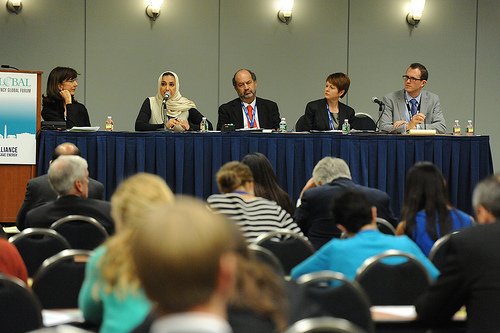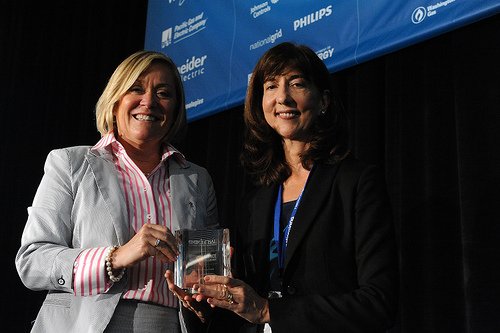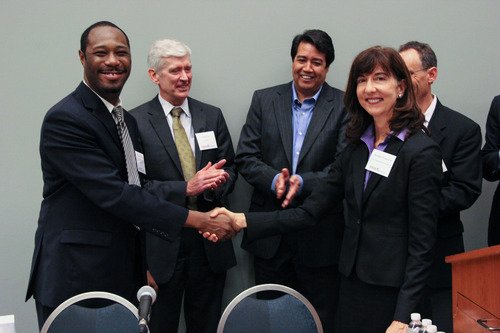How do you get to be the most energy efficient economy in the world? That's the subject of the new ACEEE International Scorecard Self-Scoring Tool, an analytic tool that helps users develop a high-level snapshot of the overall energy efficiency of a nation, state or province. That's also the title of a panel discussion I moderated recently for the 2013 Energy Efficiency Global Forum in Washington, D.C.
 Left to right: Me, Dr. Nawal al-Hosany, Odon de Buen, Dr. Gabrielle Kuiper, Dominic Marcellino
Left to right: Me, Dr. Nawal al-Hosany, Odon de Buen, Dr. Gabrielle Kuiper, Dominic Marcellino
The panel included a distinguished group of experts from the United Arab Emirates, Mexico, Australia and the European Union. I was fascinated to learn how countries/regions of such diverse economic, cultural and political circumstances are working to create more energy efficient economies and reduce GHG emissions. Gabrielle Kuiper, Senior Advisor, Climate Change, Energy and Environment, Office of the Australian Prime Minister, aptly summarized the discussion by highlighting four necessary steps:
Optimize Information: The problem with wasteful energy consumption is that energy is mostly invisible, unlike polluted air or water that people can clearly see and want to change immediately. Existing tools such as fuel gauges and electricity meters can help give visibility to energy, but countries need larger-scale mechanisms to measure and manage energy and disclose energy use to the public.
Reform Energy Prices to ensure that energy prices reflect the full costs, including putting a price on carbon.
Build Institutions to develop the capacity to do energy efficiency, including creating new facilitating agencies (such as financing institutions), beefing up spending on energy efficiency and related R&D, and supporting private organizations to develop energy efficiency as a profit center.
Strengthen Governance through strong leadership, ambitious targets, regularly updated codes and standards, mandatory audit requirements and strict enforcement. Australia sometimes evens imprisons energy efficiency offenders (!)
The discussion got me thinking about China and how it is progressing in its quest to become more energy efficient. According to the ACEEE 2012 International Energy Efficiency Scorecard, China outscored every other country in building energy efficiency and also had a very strong score in the transportation efficiency; however, low scores in its national efforts and in industrial efficiency brought down its overall ranking. So much more still needs to be done.
At the national level, among other things, China issued landmark Demand Side Management (DSM) regulations in November 2010, which for the first time set mandatory energy saving and demand reduction targets for China's grid companies. Since then, the grid companies have responded by setting up dozens of energy service companies (ESCOs) to help their customers implement energy efficiency projects, providing training and education through "energy user networks," and implementing numerous measures to improve their own grid system efficiency – no small feat for these gigantic state-owned enterprises.
Yet challenges in DSM remain. Grid companies still face an inherent conflict of interest because they lose electricity sales, i.e. revenue and profit, whenever they help their customers save electricity. That may be in part why the majority of the savings achieved by the grid companies to date are through grid system efficiency improvement projects – improving transmission and distribution system efficiency benefits the grid companies' bottom line, while helping customers reduce energy use does not. That is not to say that the grid companies are not making earnest efforts to meet their targets – they are, and we applaud their efforts. However, the competing objectives of meeting profit vs. DSM targets means that the grid companies will at most meet their DSM obligations but will have no motivation – nor receive internal company support – to exceed the targets.
As a result, while China's energy intensity is decreasing steadily, its electricity intensity is on the rise. This rising trend is expected to continue and may even accelerate in China's growing urban centers. The grid companies can be a great resource to help consumers optimize their electricity consumption and capture cost-effective energy efficiency, but they can only do so if their performance objectives are properly aligned. China needs to develop the "next generation" of DSM policies that will provide revenue recovery for the grid companies for helping their customers achieve energy savings and demand reduction (such as the "decoupling" mechanism which dissociates company revenue and electricity sales), as well as develop performance incentive mechanisms to motivate the grid companies to not only meet but exceed the DSM targets.
The good news is that certain cities in China are also moving forward with energy efficiency. In fact, the Alliance to Save Energy awarded the city of Suzhou an EE Visionary Award this year for its outstanding contribution to modernizing the city through the promotion and implementation of energy efficiency and DSM programs. Suzhou's voluntary Energy Efficiency Star Program rated special mention, as did its extensive energy audit/retrofit program, which could save 7.32 million tons coal equivalent (tce) annually, and its pioneering work as one of the first four DSM pilot cities in China. I had the honor of accepting the award at the 2013 EE Global Forum on behalf of the Mayor of Suzhou, Mr. Naixing Zhou.

President of the Alliance to Save Energy, Kateri Callahan, presenting the 2013 EE Visionary Award
To continue helping China advance energy efficiency, the China-U.S. Energy Efficiency Alliance hosted a breakfast roundtable discussion following the EE Global Forum. Business and government experts discussed their successes and challenges and shared practical advice for doing business in China in the energy efficiency sector. The Alliance also signed an official Export Promotion Partnership with the U.S. Commercial Service, which is the trade promotion arm of the U.S. Department of Commerce's International Trade Administration. The partnership will facilitate access to Chinese markets for U.S. businesses in the energy efficiency sector -- a win for both U.S. businesses and energy efficiency in China. The partnership comes just as the Alliance is gearing up for a trade mission from California to China, which will bring U.S. businesses and government officials to meet their counterparts in China and form partnerships.

Launching the official partnership with Antwaun Griffin, Deputy Assistant Secretary of the Commerce Department's International Trade Administration (May 22, 2013)
During the Roundtable, Robert Weisenmiller, Chairman of the California Energy Commission and member of the Alliance's Leadership Council, spoke of California's remarkable progress in improving energy efficiency. China is California's third largest trading partner, and Governor Jerry Brown just signed a number of national and subnational agreements with China to jointly tackle climate change. Building on these agreements, the Alliance trade mission will promote concrete cooperation with Chinese partners on clean energy policies, technologies, and business opportunities.
China should and must continue to become a highly energy efficient economy. We look forward to seeing the results of these efforts on next year's ACEEE International Energy Efficiency Scorecard.
(This post was co-authored with my colleagues NRDC Energy Efficiency/DSM Project Director Mona Yew and Christine Xu.)


